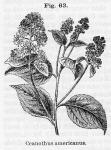Ceanothus.—Red-Root.

 Preparation: Compound Syrup of Red-Root
Preparation: Compound Syrup of Red-Root
The root, root-bark, and leaves of Ceanothus americanus, Linné.
Nat. Ord.—Rhamnaceae.
COMMON NAMES: Red-root, New Jersey tea, Wild snowball.
Botanical Source.—This plant has a large root, with a red or brown epidermis, containing many small, white veins, and tolerably thick; body of the root dark-red. The stems are from 2 to 4 feet high, slender, suffruticose, with many reddish, round, smooth branches, the younger ones pubescent. The leaves are ovate or oblong-ovate, acuminate, serrate, 3-veined, rather smooth above, downy, with soft, reddish hairs beneath, and often heart-shaped at base. The flowers are minute, white, in long, crowded panicles from the axils of the upper leaves. Calyx 5-cleft, campanulate, cut round after flowering, with the base permanent and adhering to the fruit. Petals 5, saccate-arched, with long, spreading claws. Stamens 5, exserted, inclosed in the curiously vaulted corolla; anthers ovate, 2 celled; ovary, 3-angled. Fruit dry, obtusely triangular, 3-celled, loculicidal, with papery valves; cells 1-seeded; seed convex outside, concave within (G.—W.).
History.—Ceanothus americanus is indigenous to the United States, and is very abundant in the West; it grows in dry woodlands, barrens, etc., flowering from June to August. The leaves are astringent and slightly bitter, and have been used as a substitute for tea, to which they have a strong resemblance when dried, both in taste and odor. The root is the medicinal part, and has a taste and smell somewhat resembling those of the peach leaf. It has been occasionally used for coloring. Water extracts its active principle.
Description.—Red-root is a long, cylindrical, thick, irregularly contorted, branching root, with either a simple or branched head, with knotty tubercles. Its surface is finely corrugated, and of a rusty-brown color. The bark is thin, and breaks with a granular fracture; the wood, light brownish-red, and tough. To the taste red-root is astringent and bitter, but has no odor.
Chemical Composition.—The leaves are said to contain tannin, a soft resin, a bitter extractive, a greenish coloring matter almost identical in color and taste with green tea, gum, a volatile substance, lignin, and a principle called ceanothine, but which does not appear to exert as much therapeutical value as the infusion or fluid extract of the root-bark. When purified, ceanothine is white; its odor and taste is similar to that of green tea; it is soluble in water, but insoluble in alcohol, ether, and carbon disulphide. Chloroform is its best solvent. Clinch (Amer. Jour. Pharm., 1884) found in the leaves a volatile oil. The bark contains considerable tannin and ceanothine.
F. C. Gerlach (Amer. Jour. Pharm., 1891) found ceanothus-red, tannin, volatile oil, gallic acid, resin, vegetable wax, fixed oil, starch, saccharose, glucose, mucilage, albuminoids, calcium oxalate, and the alkaloid ceanothine, which he found to resemble caffeine in not forming salts, but differing in not being precipitated with Mayer's reagent (A. P. A. Proc., 1892).
Action, Medical Uses, and Dosage.—Astringent, expectorant, sedative, antispasmodic, and antisyphilitic. Ɣ It is used in gonorrhoea, dysentery, asthma, chronic bronchitis, whooping-cough, and other pulmonary affections. Dose of a strong decoction, 1 tablespoonful 3 or 4 times a day. It has likewise been successfully used as a wash and gargle in the aphthae of children, sore mouth subsequent to fever, and in ulceration of the fauces attendant on scarlatina.
Besides the old uses, as given above, ceanothus has been found to be a useful gastric, hepatic, and splenic stimulant, and it is in splenic troubles that its action is most favorable. Scudder (Spec. Med.), states that it is indicated by splenic enlargement, with sallow, doughy skin, and expressionless face. Webster gives as indications, deep-seated splenic pain, though no enlargement be detectable, and for the pain of splenic hypertrophy, as well as for sympathetic, painful conditions depending upon splenic wrong. Its action is compared to that of carduus marianus, influencing the hepatic, and more so the splenic vessels, overcoming congestion. Hypertrophy of the spleen and splenitis of malarial origin are met with it. The cases of splenitis to which it is specially adapted are not acute, but rather sub-acute, after the active symptoms have passed, and when pressure does not markedly aggravate the pain. It was much used during the Civil War for malarial splenitis.Copious catarrhal profluvia in non-inflammatory conditions are benefited by its astringency. Ɣ For hepatic and splenic disorders the tincture of the leaves is preferred. Dose: Strong decoction, fl℥ss 3 times a day; specific ceanothus 1 to 10 drops.
Specific Indications and Uses.—Enlarged spleen; sallow, doughy skin expressionless countenance; non-inflammatory, catarrhal states, with profuse secretion.
Related Species.—Ceanothus ovalis, Bigelow. United States, Vermont to Rocky Mountains. Has oval leaves, and is probably similar to above species.
Ceanothus reclinatus, De Candolle. Mexico and West Indies. Used by the natives in gonorrhoea, syphilis, dysentery, ulceration of the mouth and fauces, and cancer.
Ceanothus azureus, Desfontaines, and Ceanothus caeruleus, Lagasca. Mexico. Febrifuge.

